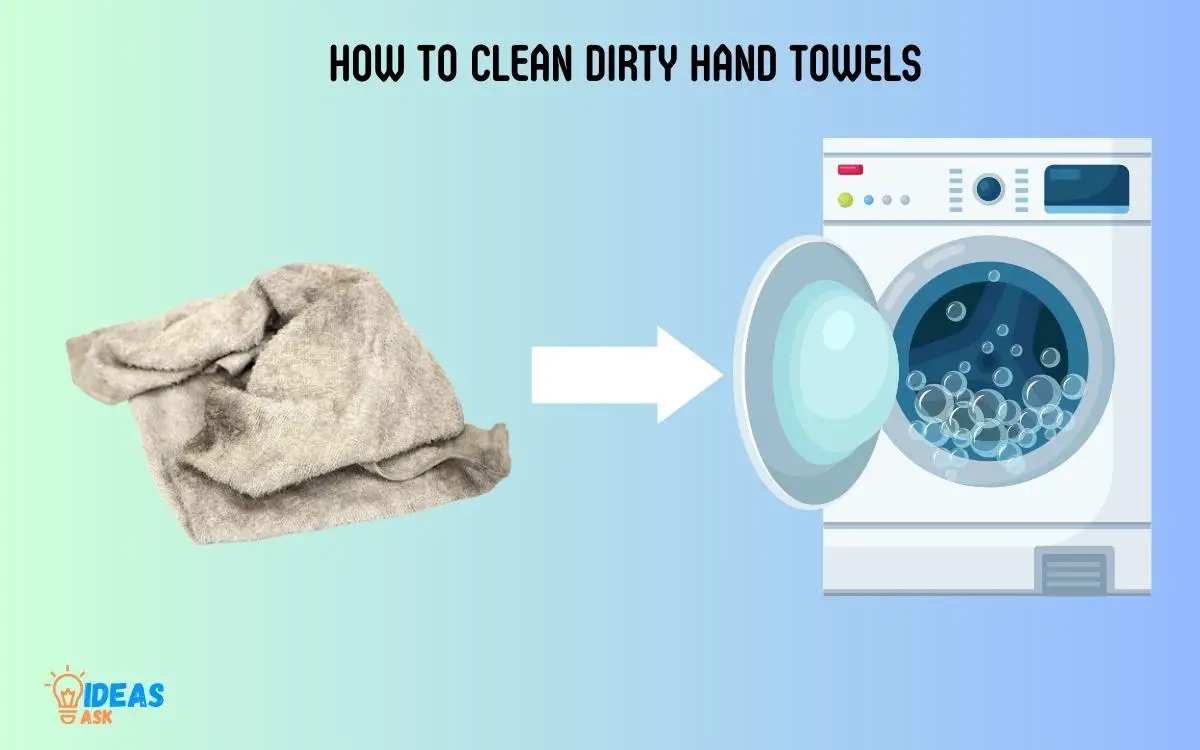How to Clean Dirty Hand Towels? 4 Easy Steps!
To clean dirty hand towels, you should pre-treat any visible stains, soak the towels in hot water with half a cup of baking soda and your regular detergent, run a heavy-duty wash cycle, and allow them to air dry or dry on a low heat setting.
Hand towels get used frequently, collecting dirt and bacteria, thus they need to be cleaned properly to maintain hygiene. Pre-treating stains helps to remove them effectively before the wash.
The combination of baking soda and detergent in hot water helps in deep cleaning and deodorizing the towels. Running a heavy wash cycle ensures the towels get thoroughly cleaned.
Finally, drying towels properly prevents any leftover moisture that may cause a foul smell or mould growth.
Hand towels are commonly used for drying hands and wiping surfaces, leading to quick accumulation of dirt and bacteria.
To ensure they are hygienically clean, pre-treat any visible stains and soak the towels in a mixture of hot water, baking soda, and your regular detergent.
This not only deep cleans the towels but also helps in deodorizing them. Run a heavy-duty wash cycle for thorough cleaning and allow the towels to air dry or dry on a low heat setting to avoid any leftover moisture that may cause mould growth or a foul smell.

Key Takeaway
Understanding The Importance Of Clean Hand Towels
Properly cleaning your hand towels is crucial for maintaining good hygiene. Discover effective methods to remove dirt and bacteria from your towels, ensuring the health and well-being of yourself and others.
Hand towels play a crucial role in maintaining personal hygiene, ensuring that we can effectively and conveniently dry our hands after washing them.
While we may think of hand towels as harmless items, they can actually harbor various germs and bacteria if not kept clean.
Therefore, understanding the importance of clean hand towels is essential for the overall well-being of ourselves and those around us.
The Role Of Hand Towels In Maintaining Hygiene:
- Hand towels are used to dry our hands after washing, removing excess moisture and preventing the growth of bacteria on our hands.
- They help to maintain personal cleanliness by promoting proper hand hygiene practices.
- Hand towels provide a hygienic way to dry hands, avoiding the need for shared or communal hand-drying methods that can contribute to the spread of germs.
The Potential Health Risks Of Using Dirty Hand Towels:
- Dirty hand towels can become a breeding ground for various microorganisms, including bacteria, viruses, and fungi.
- These microorganisms can transfer onto our hands when we use the towel and potentially cause skin infections, respiratory illnesses, or gastrointestinal issues.
- The accumulation of dirt, oils, and dead skin cells on dirty hand towels can promote the growth of bacteria, leading to an unpleasant odor.
How Dirty Hand Towels Can Pose Health Risks:
- Bacteria, such as Staphylococcus aureus or E. Coli, can thrive in the moist environment of dirty hand towels.
- When we use a contaminated towel to dry our hands, we can unknowingly transfer these bacteria onto our skin, increasing the risk of infections.
- Dirty hand towels can also become a source of cross-contamination within households, especially if used by multiple individuals.
Regular Cleaning And Maintenance Of Hand Towels:
- Hand towels should be washed frequently, ideally after every two to three uses, to prevent the buildup of bacteria and odors.
- Using hot water and detergent when washing hand towels is crucial for effectively removing germs and maintaining cleanliness.
- It is advisable to avoid sharing hand towels with others to minimize the risk of spreading germs and infections.
Maintaining clean hand towels is crucial for personal hygiene and the prevention of potential health risks.
By understanding the importance of regular cleaning and proper maintenance, we can ensure that our hand towels remain a safe and hygienic tool for drying our hands.
So let’s take the necessary steps to keep those hand towels clean and promote good hand hygiene practices.
Step 1: Signs That Your Hand Towels Need Cleaning
If you start noticing unpleasant odors, stains, or an overall rough texture on your hand towels, it’s a clear sign that they’re due for a thorough cleaning.
Regularly washing your hand towels using hot water and detergent can help keep them fresh and hygienic.
Do you ever wonder how clean your hand towels are? Over time, these seemingly innocent linens can become havens for bacteria and odor. It’s essential to recognize the signs that your hand towels need cleaning to maintain proper hygiene.
Here are some key indicators to watch out for:
Foul Odor:
- The presence of a persistent, unpleasant smell is a clear sign that your hand towels are dirty.
- If your towels emit a musty or sour odor, it could indicate the growth of bacteria or mold.
- The foul smell is often a result of residual soap, dead skin cells, and body oils that accumulate on the towels over time.
Discoloration Or Stains:
- Noticeable discoloration or stains on your hand towels serve as visible evidence that they require immediate cleaning.
- Stains can appear as yellowish patches, especially around the areas where you frequently dry your hands.
- Discoloration is commonly a result of dirt, sweat, or food particles that have embedded themselves into the fabric.
Unpleasant Texture:
- When your once-soft hand towels start feeling rough or scratchy against your skin, it’s a sign that they are in need of a thorough cleaning.
- The unpleasant texture is often a result of detergent residue, dried food particles, or bacteria buildup.
- Regular washing and proper drying techniques can help maintain the softness of your towels.
By being attentive to these signs, you can ensure that your hand towels remain clean and hygienic.
Regularly washing them can help eliminate bacteria, odors, and stains, keeping your towels fresh and enjoyable to use. Plus, it’s an essential part of maintaining a healthy and clean environment in your home.
Step 2: Preparing Hand Towels For Washing
Learn how to effectively clean dirty hand towels with these simple steps. From pre-soaking to using the right detergent, you can ensure your hand towels are fresh and hygienic after each wash.
Sorting Towels Based On Color And Fabric Type:
It’s important to sort your hand towels before washing them to ensure optimal cleaning results.
Here’s how you can efficiently sort them based on color and fabric type:
- Separate towels by color: Divide your hand towels into separate piles based on their colors. This will prevent color bleeding and keep your towels looking fresh.
- Sort by fabric type: Different fabrics may require specific care instructions. Sort your towels into piles based on their fabric type, such as cotton, linen, or microfiber.
Removing Any Excess Debris Or Lint:
Before washing your hand towels, it’s essential to remove any excess debris or lint.
Here’s how you can do it effectively:
- Shake off loose dirt: Take each towel and give it a good shake to remove any loose dirt or debris.
- Use a lint roller: Roll a lint roller over the surface of the towel to pick up any lint or hair that might be clinging to it.
- Brush off remaining debris: Use a soft-bristle brush or your hand to brush off any remaining debris from the towel’s surface.
Treating Specific Stains Or Spots:
Sometimes, your hand towels may have specific stains or spots that require special treatment.
Here are some common stains and how to treat them:
- Food stains: For food stains, pre-treat the affected area with a mixture of dish soap and warm water. Let it sit for a few minutes before washing as usual.
- Blood stains: To treat blood stains, soak the towel in cold water and gently rub the stain with a mild detergent. Rinse thoroughly before washing.
- Grease stains: For grease stains, apply a small amount of dishwashing liquid directly to the spot. Rub gently, then wash the towel in hot water.
- Makeup stains: To tackle makeup stains, pre-treat the area with a stain remover or a mixture of water and rubbing alcohol. Wash the towel as usual after treating.
Remember, cleaning your dirty hand towels regularly will not only maintain their freshness but also ensure their hygienic use.
By sorting them based on color and fabric type, removing excess debris or lint, as well as treating specific stains appropriately, you can successfully clean your hand towels and keep them looking their best.
Step 3: Proper Washing Techniques For Hand Towels
Learn the proper washing techniques for hand towels to effectively clean dirty towels. Follow these guidelines for optimal results in keeping your towels fresh and hygienic.
Hand towels are an essential part of our daily lives, providing us with a convenient way to dry our hands. However, over time, these towels can become dirty and unsanitary if not properly cleaned.
In this section, we will explore the proper washing techniques for hand towels, including selecting the right detergent and temperature, different washing methods for different fabrics, and the option of adding baking soda or vinegar for a deeper clean.
Selecting The Right Detergent And Temperature:
- Choose a detergent that is suitable for your hand towels’ fabric and color. Consider using a gentle or baby detergent for delicate fabrics.
- Opt for a fragrance-free detergent to minimize any potential skin irritations.
- Check the care label on your hand towels for recommended washing temperatures. Use hot water for white towels and cold or lukewarm water for colored towels to prevent color fading.
Different Washing Methods For Different Fabrics:
- Cotton towels: Machine wash cotton towels with a regular laundry cycle using a mild detergent. Separate them from clothing items with zippers or hooks to avoid any snagging. Avoid using fabric softeners as they can hinder absorbency.
- Microfiber towels: Machine wash microfiber towels separately using warm water and a gentle detergent. Avoid using bleach or fabric softeners, as they can damage the fibers.
- Linen towels: Check if your linen hand towels can be machine washed or if they need to be hand washed. If deemed safe for machine washing, use a gentle cycle and mild detergent.
- Decorative towels with embellishments: Hand wash these towels gently using a mild detergent. Avoid using bleach or harsh chemicals that can damage the embellishments.
Adding Baking Soda Or Vinegar For A Deeper Clean:
- Baking soda: Add half a cup of baking soda to your regular detergent to boost cleaning power and eliminate any odors. This natural ingredient also helps to soften the towels.
- Vinegar: Adding half a cup of white vinegar during the rinse cycle can help to remove soap residue and restore the towels’ absorbency. The vinegar scent will dissipate after drying, leaving your towels fresh and clean.
By following these proper washing techniques, you can ensure that your hand towels remain fresh, clean, and germ-free.
Remember to check the care labels on your towels for any specific instructions and enjoy the feeling of drying your hands with clean, hygienic towels every time.
Step 4: Drying And Storing Hand Towels
Learn how to effectively clean dirty hand towels and keep them fresh by following these simple steps for drying and storing them. Proper care and maintenance will ensure your hand towels stay hygienic and last longer.
After washing your hand towels, the next step is to properly dry and store them to maintain their softness, absorbency, and hygiene. In this section, we will explore the two primary methods of drying hand towels – air drying and machine drying.
We will also provide you with valuable tips on preserving towel softness and absorbency, as well as the correct way to store them to avoid bacterial growth.
Air Drying Vs. Machine Drying:
Air drying:
- Hang the hand towels on a towel rack or clothesline in a well-ventilated area.
- Ensure that the towels are evenly spread out to allow maximum airflow.
- Avoid direct sunlight, as it can cause the colors to fade over time.
- Patience is key with air drying, as it may take longer compared to machine drying.
Machine drying:
- Select a low or medium heat setting to prevent damage to the fabric.
- Avoid overloading the dryer, as it can lead to poor drying performance.
- Tumble the towels with dryer balls or tennis balls to fluff them up.
- Remove the towels promptly when they are fully dry to prevent wrinkles.
Tips For Preserving Towel Softness And Absorbency:
Use vinegar:
- Add half a cup of white vinegar to the rinse cycle when washing towels to remove detergent residue and restore softness.
- This natural method also helps to eliminate unpleasant odors.
Avoid fabric softeners and dryer sheets:
- Fabric softeners can leave behind a coating that reduces absorbency.
- Dryer sheets can contain chemicals that can impact towel softness and effectiveness.
Shake towels before folding:
- Give the towel a good shake when removing it from the dryer to fluff up the fibers.
Minimize detergent usage:
- Using too much detergent can leave residue on the towels, making them less absorbent.
- Follow the manufacturer’s instructions for the recommended amount of detergent to use.
Separate towel types:
- Wash different types of towels separately to prevent lint from getting stuck on them.
Proper Storage To Avoid Bacterial Growth:
Ensure towels are completely dry:
- Make sure hand towels are thoroughly dry before folding and storing them.
- Moisture can lead to the growth of bacteria and mildew.
Preserve ventilation:
- Store towels in a cool, well-ventilated area to prevent the development of musty odors.
Avoid contact with other surfaces:
- Keep hand towels away from the walls or other surfaces that may transfer dirt or bacteria.
Regular washing:
- Wash hand towels on a regular basis, ideally once every three to four days, to maintain cleanliness and freshness.
By following these methods and tips for drying and storing your hand towels, you can prolong their lifespan, maintain their quality, and ensure optimal cleanliness for you and your family.
Conclusion
To ensure your hand towels stay fresh and clean, it is essential to periodically wash them properly. By following the simple steps outlined in this blog post, you can effectively remove dirt, bacteria, and odors from your hand towels.
First, separate colors to prevent bleeding and wash them in hot water with a good detergent. Avoid using fabric softeners, as they can create a buildup on your towels. Also, consider adding a cup of white vinegar during the rinse cycle to boost the cleaning process.
Finally, properly dry your towels, either in a hot dryer or by hanging them in direct sunlight. By implementing these tips, you can maintain fresh, hygienic hand towels that are free from germs and unpleasant smells.
Stay committed to a regular towel-cleaning routine, and enjoy the luxury of soft, clean towels every time.






